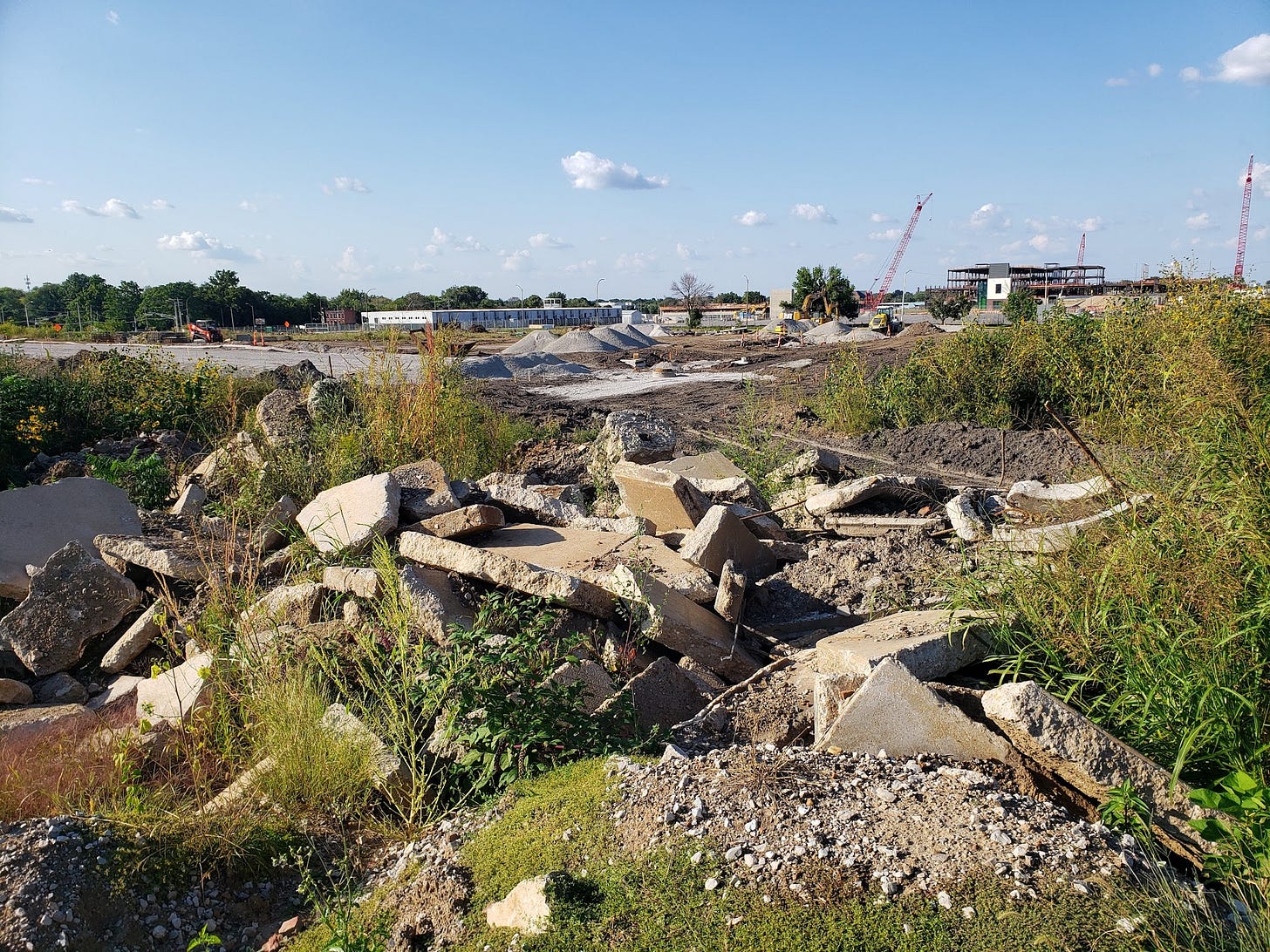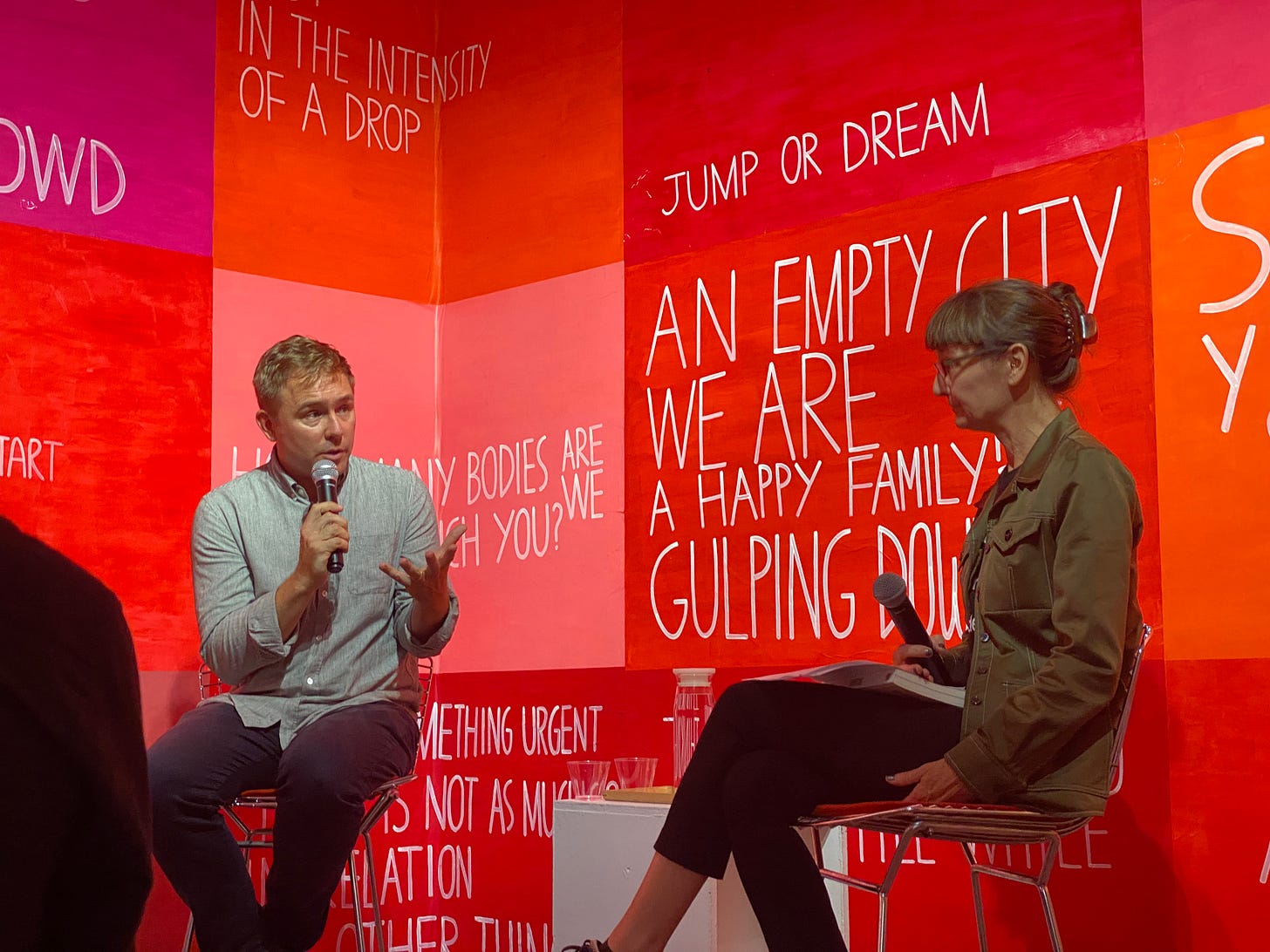S K Y L I N E | 38 | The World Is What We Make It
The built environment is just the facade, so to speak.
Welcome! If someone forwarded you SKYLINE, sign up here to receive it weekly.
Hello, Skyline readers! It’s officially autumn, and the change in season seems to have brought with it a renewed energy for design and discourse. At least that’s the impression I get from looking at this week’s dispatches, news, and events. The design fairs are back, opening and closing around the globe faster than you can say “vaccine passport.” The start of fall semester brings a wellspring of lectures and events across the nation’s colleges and universities, some even returning to in-person attendance. And, in New York City, the Center for Architecture is reopening to the public after an 18-month-long hiatus, coinciding with institution’s annual Archtober Festival.
In this edition of Skyline, four very different dispatches all highlight an obvious but important truth about the practice of architecture: The built environment not only reflects our culture’s aesthetic preferences, but it inexorably articulates the timeless values and preoccupations that have been with humanity for generations. Whether that is the pursuit of beauty for its own sake, a sense of hometown pride, the fight for justice, or the burden of legacy, each of these dispatches showcases a powerful but simple motivation transformed into what we call Design.
— Anna Gibertini, guest editor
DISPATCHES
9/21: PORTRAIT OF THE ARCHITECT
On Tuesday night, a masked-n-vaxxed crowd gathered at STOREFRONT FOR ART AND ARCHITECTURE to hear artist JUSTIN BEAL speak on his new book, Sandfuture, with architectural historian FELICITY SCOTT of Columbia GSAPP. In opening the event, Executive Director and Chief Curator JOSÉ ESPARZA CHONG CUY remarked that Storefront was a “fitting space” to host the launch of a book “very much about New York City and the built environment,” since, with the iconic facade panels opened to the street, the gallery became “a part of the noisy city we all live in.” Certainly, the active street life served as a welcome counterpoint to the noise-cancelled, sterile environment of zoom calls.
Beal opened with a short reading that gave a peek into the multiple threads woven together in this biography-cum-history of Minoru Yamasaki, the architect famously, or infamously, of the World Trade Center towers in New York and Pruitt-Igoe Housing Complex in St. Louis, “two major projects that exploded on live television, thirty years apart,” as Beal put it. “There are very few events in the history of architecture, and I think those are definitely on the shortlist of the most spectacular.” But, as Beal himself was keen to point out, these two projects have historically overshadowed the rest of Yamasaki’s career, something he hoped the book would serve to amend. The book is not, however, a work of architectural history. As Scott highlighted in reading a small passage, Beal’s own personal narrative as a “lapsed architect”—his encounters with, rubbings up against, and experiences in the worlds of both architecture and art—saturates the prose. “What I wanted do to”, said Beal, “was to write about architecture in a way that felt closer to my own experience of it, which is quite personal…and most architectural writing isn’t terribly personal.” The event concluded with conversation over mezcal and wine spilling out into the street through the open panels, and, if it’s any indication, leaving behind a previously full, now barren book-sales table. — NICHOLAS RAAP
9/22: MAPPING ATROCITY
“I’m an architect, and I now increasingly refer to myself as a journalist as well” said ALISON KILLING, speaking virtually at the University at Buffalo Wednesday night. As the first architect to win a Pulitzer, this label isn’t unfounded. Her talk, Investigating Xinjiang’s Network of Detention Camps, focused on the methods she and her co-awardees developed for investigating human rights abuses perpetuated by the Chinese state against Turkic Muslims. The research, published on BuzzFeed, used satellite imagery and analytical techniques familiar to architectural practice to locate and identify almost 300 camps in the province of Xinjiang. “I brought a lot of experience to the table in this because of my architectural background, [and] how I used mapping and imagery to [previously] work on migration,” said Killing.
Questions around the transmission, censorship, and authenticity of information were at the heart of the matter from the very beginning. Censored satellite imagery on Baidu was paired against uncensored images on other platforms. Contemporary images were compared with historical ones, showing the history of the camps’ construction. Acquired government documents stating regulations for detainment facilities were used to determine occupancy and program types. Interviews with former detainees corroborated locations and spatial characteristics inside. While a comparison to the work of Forensic Architecture might be apt, Killing’s journalistic approach and focus is distinctive and was central to the project: “I think what’s powerful about what we were able to do is that we have provided rigorous evidence of the scale of this detention program, showing where it is, doing this work to calculate the capacity [of the camps]…but also tell the human stories that show what the impact of this is on a human level. I think that is a very powerful way of telling people what is happening and why it is important.” — NICHOLAS RAAP
9/21: RISE UP, FLY-OVER
“Architecture’s responsibility should extend beyond our own labor as architects. We must think about both the users of the final product and the craftspeople who build projects.” — PATRICIA ACEVEDO FUENTES, 2021 Bush Fellow
This was the core message of South Dakota State University’s Building Arts and Labor Symposium, a day-long exploration of the industry’s relationship (or lack thereof) to the individuals most affected by the design, build, and completion of architectural projects. The symposium built on the practice and scholarly work of JESSICA GARCIA FRITZ and FEDERICO GARCIA LAMMERS of LAB_OR, which examines architectural contract documents as a guide to understanding architecture’s relationship to its stakeholders. Most of the participants—including a union leader, a professor, a fellow, and a community advocate—were South Dakota–based, and spoke passionately about the need for a re-ordering of architectural practice in the Great Plains.
PEGGY DEAMER, Professor Emerita of Yale Architecture, began the symposium with a keynote focusing on labor and architectural contracts. From there, the panelists shared stories and insights into community-based efforts to bring positive change to South Dakota. Union leader KOOPER CARAWAY championed the growing presence of unions, as well as international examples of vernacular design repurposed into 21st century workers’ housing that could be used in the States. Architectural instructor BRETT GRINKMETER laid out futures for entry into architectural college and alternative models for post-secondary education. New Bush Fellow Patricia Acevedo Fuentes discussed her architectural work advocating for users in non-urban contexts. Of particular interest, however, were the representatives from Thunder Valley Community Development Corporation, LYNETTE KILLSBACK and LYNN CUNY. Together they shared the organization’s work to foster community in South Dakota’s Pine Ridge Reservation through providing Lakota youth with soft skills and job training in the construction and architectural professions.
As a native of the Great Plains, this symposium underscored a growing feeling inside myself: Our region does not need acknowledgement, much less validation, from the coastal institutions. We have everything we need to do great architecture right here. — CHARLES WEAK
9/13: REVIVING THE SUBLIME
“When you rely on emotional [design] language like nostalgia or enchantment, you can’t create work that has a broad relevance,” explained landscape architect ROBIN WINOGROND, co-founder of the Swiss firm Studio Vulkan, in a recent lecture at Harvard GSD (In Search of Geographical Re-Enchantment). “That’s why I pursue re-enchantment.”
What differentiates enchantment from re-enchantment? Winogrond draws from myriad sources, including poetry, visual art, anthropology, and phenomenology (specifically Merleau-Ponty's The Phenomenology of Perception). For the architect, enchantment speaks to the emotional, even metaphysical sensation of encountering a natural space for the first time. There is no perception of oneself in this interaction; the viewer is fully absorbed in the experience of encountering something other (what the Romantics called the Sublime or the “agreeable horror”). With re-enchantment, the viewer still experiences the arresting qualities of the space but stays rooted in his body the second time around—more importantly, he is keenly aware of his own self experiencing the space. Winogrond calls this a “marriage between what is happening inside and outside ourselves” and it leads to the “catalyst for imagination.”
With that catalyst, Winogrond deftly alchemizes projects that are as beautiful as they are philosophical—a series of flagstones with embedded fossils at the St. Gallen Natural History Museum’s garden; a sound barrier on the side of a Zurich highway made from etched glass; a manufactured hill with a gravel base and a polished terrazzo summit serve as subtle statements of deft and purposeful aesthetics. “The point of re-enchantment is to suss out the poetic potential of a site, to fascinate, and to defy expectation,” says Winogrond. — ANNA GIBERTINI
MEANWHILE IN ST. LOUIS

Most Clicked Link
What captured Skyline readers’ attention last week? Álvaro Siza’s 611 W56 Tower.
In the News
Despite the persistence of the worldwide COVID-19 pandemic, design fairs are back. Milan’s Supersalone concluded on September 10th and was immediately followed by Maison&Objet, which wrapped up on September 18th. Design Miami/Basel (held in Switzerland) kicked off on September 21st, and the 2021 Seoul Biennale is in full swing. Continuing with Paris news, the restoration of Notre Dame remains on schedule, with an expected April 2024 reopening date. Christo and Jeanne-Claude’s L’Arc de Triomphe Wrapped was a cause célèbre. Stateside, the 2021 Chicago Architecture Biennial opened on September 18th and will run through the first half of December. New York mayoral hopeful Eric Adams proposed turning 25,000 shuttered hotel rooms into homeless housing. Finally, seven prominent paint brands announced their 2022 Colors of the Year and they’re all dusty shades of green or blue. No word yet on Pantone’s pick(s).
DATELINE
The week ahead…
Friday, 9/24
Design Impact – Following the Sun: Design Futures at the Intersection of Health, Equity and Climate Change (Conference)
10:30 AM | Harvard GSD
Robin Nagle: When the "Away" Becomes Real: Managing Garbage in New York City
12:25 PM | Cornell AAP
WIP COLLABORATIVE: WOMEN IN PRACTICE | WORK IN PROGRESS
1:00 PM | Columbia GSAPP
Exhibition Opening, Plan Unplanned: Ideas for an Affordable Chinatown
4:00 PM | citygroup
Saturday, 9/25
CUSAP X CLIMATE WEEK CLOSING CELEBRATION
6:00 PM | Cooper Union
Monday, 9/27
Pluriverse Rising: Decolonizing Design
6:30 PM | Columbia GSAPP
Tuesday, 9/28
PLURIVERSAL DESIGNING AND THE RE-EARTHING OF CITIES with WAI Think Tank, Nora Akawi
12:00 PM | Cooper Union
Wednesday, 9/29
Building Identities Through My Practice—The Personality of Architecture
12:00 PM | Rice University
ARCHITECTURE LECTURE: SEAN CANTY | HARVARD UNIVERSITY GRADUATE SCHOOL OF DESIGN
1:00 PM | UC Berkeley
Modernism as Branding: Selling Thrift, Soap and Plexiglas
6:30 PM | AIANY
Thursday, 9/30
Harnessing Extraordinary Mechanics for Structural Design with Sigrid Adriaenssens
6:00 | MIT
Friday, 10/01
Center for Architecture Reopening
4:00 PM | AIANY
For the complete list and future weeks, visit: nyra.nyc/events
LETTERS TO THE EDITOR
Would you like to share your thoughts? Please write to us - simply reply to this e-mail, or write: editor@nyra.nyc
Four desk editors run NYRA: Alex Klimoski, Phillip Denny, Carolyn Bailey & Nicolas Kemper (who also serves as the publisher). They rotate duties each month.
To pitch us an article or ask us a question, write us at: editor@nyra.nyc
For their support we would like to thank the Graham Foundation and our issue sponsors, TK.
To support our contributors and receive the Review by post, subscribe here.




